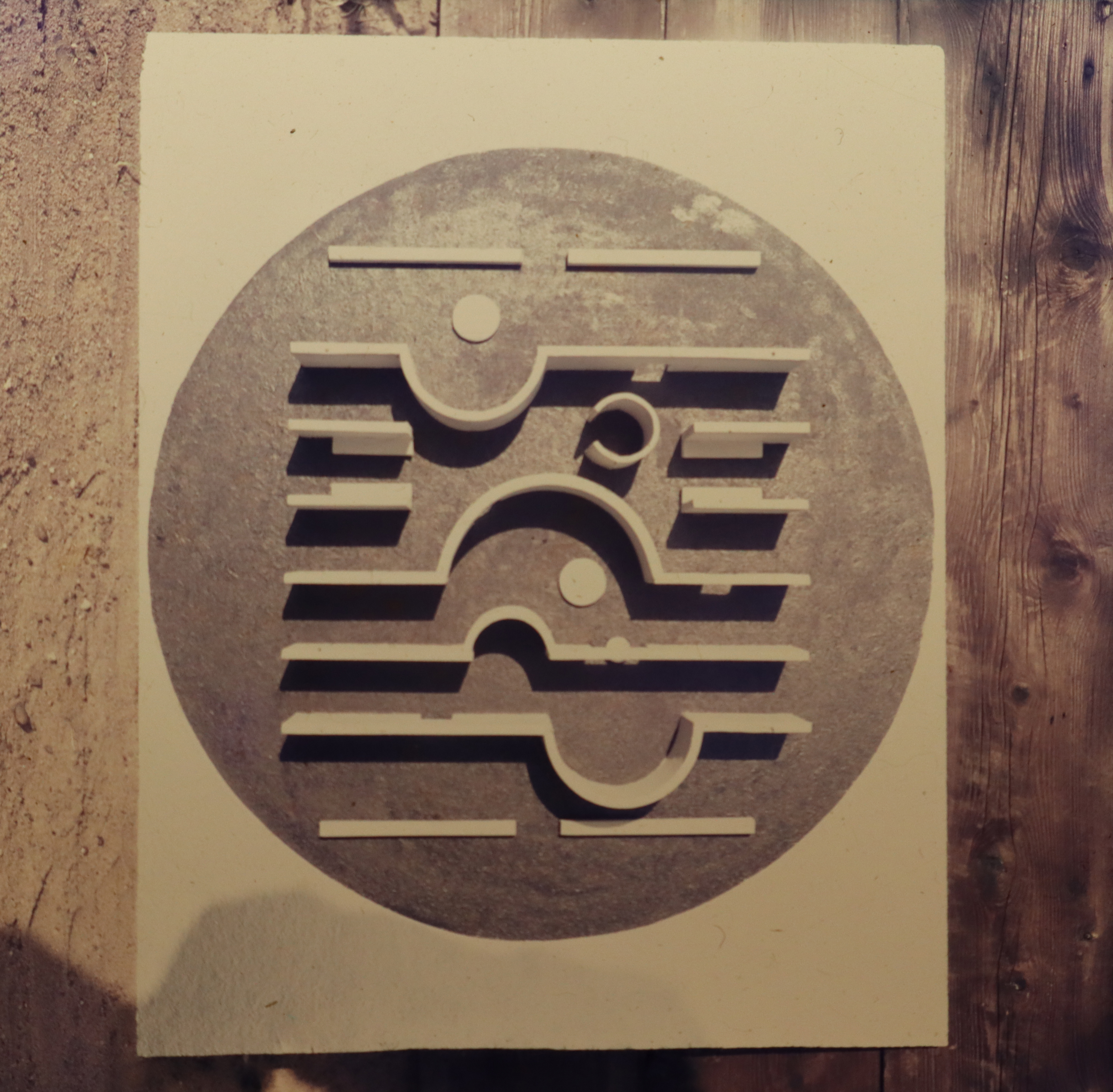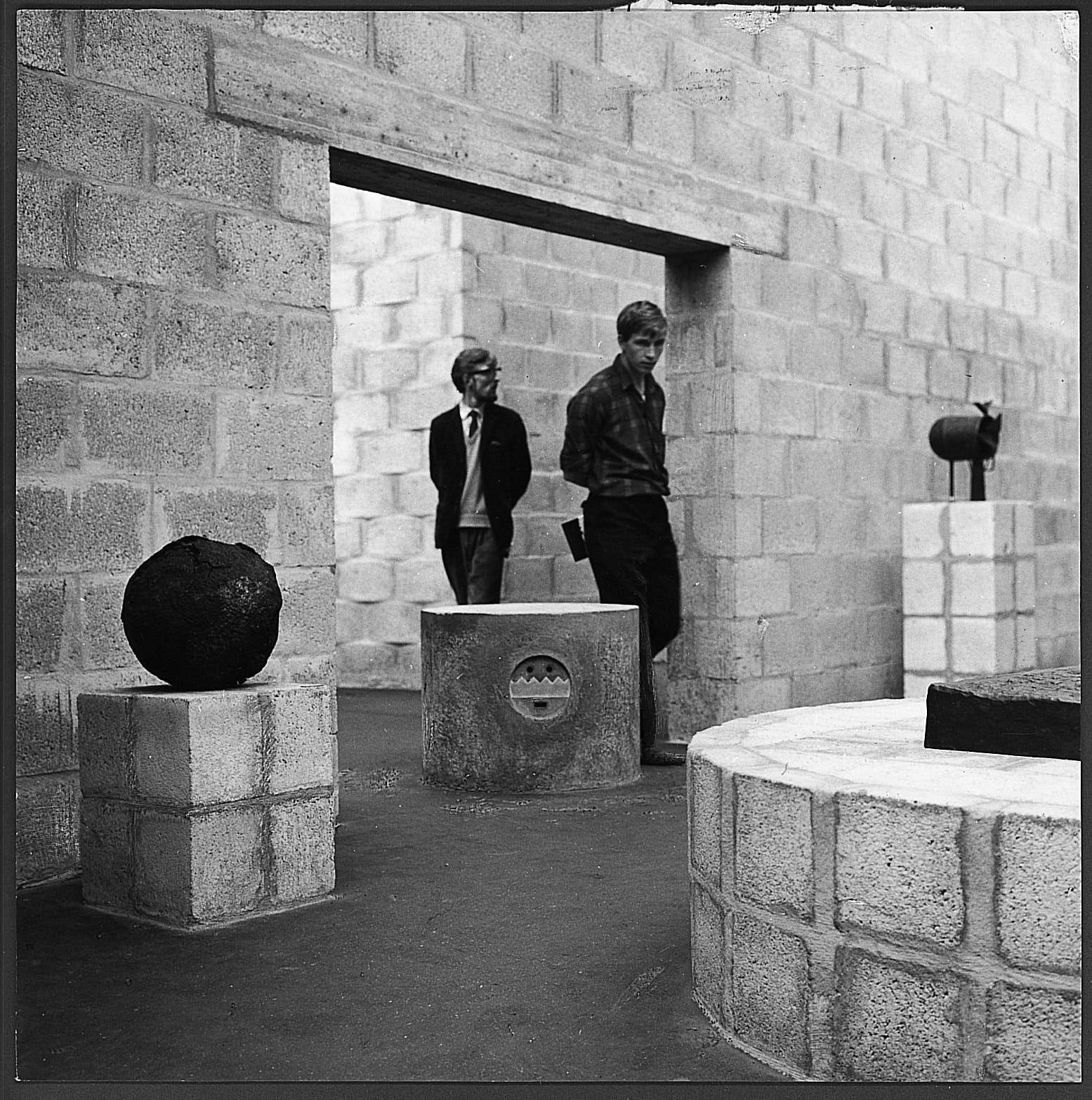DMJ – Template and Talisman

For a time, Aldo Van Eyck kept this little amulet in his pocket. An alabaster disc, inlaid with mother of pearl and jet, 30mm in diameter, it is coin-sized, weighted against and warmed by the heat of the body, passing though the fingers. Its uses are both symbolic and instrumental. It is a figure which acts.
The token came from a journey undertaken by Van Eyck in western New Mexico, near the Arizona border. This expedition was a planned conclusion to the visiting professorship held by Van Eyck at the University of Washington in December 1961, during which he began working on his book The Child, the Artist and the City.[1] This project, funded by a Rockefeller grant, was commissioned as a result of enthusiasm for Van Eyck’s teaching during a previous appointment at the University of Pennsylvania in 1960. The conditions of the book contract required the architect to spend a specific amount of time in the United States, a schedule complicated by work on his own (unbuilt) house in Baambrugge and other ongoing demands. The trip, then, formed a useful respite at the conclusion of two years of travel, teaching and deep reflection.
The Zuñi plateau sits at an elevation of 2,000m, a semi-arid plain in which every drop of water is precious. For the indigenous people who live there, the year is organised in cycles, where seeds occupy a central cultural position sustaining life and directing spiritual practice.[2] These kernels act as both symbol and gift, the means by which ongoing life in this place is made possible. In these seeds all futures are germinated.
The Zuñi people structure the year around great ceremonies, the Shalako in winter and the rain ceremony in summer. These rituals are conducted under the slopes of Dowa Yalanne, a steep sandstone mesa, forming part of the southeastern Colorado Plateau. This mountain acts as both elevation and gauge; the sweep of the sun across its surface determines times for solstice and harvest. Dowa Yalanne, jagged-edged and profiled against the sky, is therefore an instrument of rhythm, its shadows and lines marking out time in place.

On the tablet we see such a profile, picked out on a nacreous surface, inlaid distinctly across the breadth of the face. And a face is how it communicates, a benevolent roundel, a slipped party hat binding its middle. Beneath this zone we see a regular quadrangle, a shadow, a depth, a scored recess. Above it two circles, eyes, eclipsed suns, split vision. Both in jet, these elements communicate across the divide of the mountain itself.[3]
The notion of dual phenomena, later twin phenomena, is central to the thinking of Van Eyck, detailed extensively in the text previously mentioned but also in his then ongoing work—on the Amsterdam playgrounds, the recently completed Orphanage, and in his teaching, arguments and editorial contributions, fruitfully expounded within Forum magazine.[4] Open and inclusive, such thinking aimed to resolve polarities into reciprocities, and was often related to the spiral. The analogue method of constructing a spiral requires, at minimum, a pair of points. These points form the centres of alternating and sequential semicircles. Each 180-degree rotation requires a switch of position, an oscillation between equally necessary poles as the curve extends outwards. A dialogical figure, it requires a shifting, rather than a fixed centre. Like the solar and lunar movements that track across the surface of Dowa Yalanne, the eyes of the amulet are both distinct and congruous, belonging to a single spiral, a continuous unfolding.
In the cultures and traditions of the Zuñi, these thoughts were manifested in place. Here too, the circle as place (kiva) and as occasion (ceremony) were critical to habitation.[5] Van Eyck refused to reduce the circle to an abstract point, and avoided the compass.[6] Where possible, instead, his circles are drawn around objects—like the Zuñi talisman, but also, more prosaically, cups, saucers and plates frequently pilfered from cabinets— appropriated as drawing instruments for their service to drawings at various scales. These drawings are often large. 1:50 and 1:20, which results in table-sized sheets, filled with Pentel marker lines, traced around artefacts in compulsive stirring movements. At these scales, 30mm is a door swing, or a circular seat.

A circle is also, unfortunately, a wheel. Around its single centre, this kind of circle rotates, spinning in a singular direction, uncouth and uncaring. From the stoop on the Binnekant, as visitors Carel Vissler and Joost Van Roojen were waved off in their cars, an almighty crack ripped through the afternoon. When the wheel passed, a little broken face appeared on the herringbone brick pavers.
Aldo’s daughter, Tess, who was there at the time, tells me that she saw a tear run down her father’s face.
The amulet, later repaired, now sits in a perspex box on a shelf in the Van Eyck family house in Loenen. Its splintered face scarred, it continued to offer itself for use, wheeling through heaven to appear, reconstituted in stone and aluminium, in the 1966 sculpture pavilion in Sonsbeek on the face of a cylindrical concrete seat. It sits there still, offering a moment of pause.[7]

Notes
- Vincent Ligtelijn and Francis Strauven, eds, Aldo van Eyck: Writings (Amsterdam: Sun Publishers, 2008).
- The Zuñi territory, which forms part of the Pueblo region, is home to one of a number of distinct communities, each with their own histories, rituals and languages. A:shiwi (‘the people’) is the term the Zuñi use to refer to themselves or the tribe. A:shiwi neighbours include the Hopi, Akoma, and other indigenous inhabitants. The name ‘Zuñi’ comes from a word used by the Akoma to refer to the A:shiwi people. In this text, following Van Eyck, I refer to the amulet as Zuñi. For more on the A:shiwi community please refer to: https://www.ashiwi.org [accessed 18 December 2023]. The National Museum of the American Indian also has helpful resources on the Zuñi Pueblo: https://americanindian.si.edu/sites/1/files/pdf/education/poster_zuni.pdf [accessed 18 December 2023].
- Jet is a type of lignite, a kind of coal. It is extracted from the ground. The name is derived from ancient texts recalling the stone of Gagates, and known to drive away serpents, calm hysteria and evacuate worms.
- Forum was founded in 1946 by the architectural society Architectura et Amicitia. From 1959 to 1963 Aldo Van Eyck, Jaap Bakema, Joop Hardy and Jurriaan Schrofer, Herman Hertzberger and Dick Apon led the editorial team. The August 1962 issue was devoted to the Pueblo. See Ligtelijn and Strauven, op. cit., 350–370.
- Kiva is a Hopi word used to describe a circular assembly room, often semi-subterranean, used for spiritual ceremonies and gatherings. The kiva of Pueblo Arroyo appears in the 1962 (2nd) version of the Otterlo circles diagram, with the caption ‘extensions of collective behaviour’. The Otterlo circles were a form of collage manifesto produced by Van Eyck initially for the final CIAM conference held in 1959 at Otterlo in the Netherlands, and later revised for his book The Child, the Artist and the City. Their aim was to draw attention to that which is common to human experience across history, calling for a joyous expansion of lived experience through contemporary architectural production. For more on the Otterlo circles see Mariabruna Fabrizi, ‘The Otterlo circles by Aldo van Eyck: collage as condensed theory’, Piano b: Arti e Culture Visive, vol.4, no.2 (2020), 1–15.
- ‘I prefer to think of the circle as a disk or a ring. There’s no question of a centre. It’s just a muscular movement.’ Lecture given at the 1987 INDESEM conference at TU Delft. See Ligtelijn and Strauven, op. cit., 552. The text is illustrated with an image of a spiral pattern textile from Thailand.
- The original Sonsbeek pavilion was a temporary pavilion built for the 5th International Sculpture Exhibition, 1966, in Arnhem. It was later demolished. On the occasion of the demolition, the original pill-shaped seat was moved to the Van Eyck family garden in Loenen aan de Vecht, where it now sits. In 2005 the pavilion was rebuilt in the grounds of the Kröller-Müller Museum in Otterlo. There a second version of the seat can now be seen, centred on an opening, offering a chance to move left or right, or to sit still in-between.
Laura Harty is an architect and Director of the Undergraduate Architecture Programme at the University of Edinburgh. In both roles she engages daily with drawing instruments and instrumental drawings, many of which stand their ground and show us the way. Living in Perthshire, Scotland, with a young family and a long commute, most of her drawing is on other’s shoulders.
The article is included in the second issue of DMJournal, Drawing Instruments: Instrumental Drawings.
Find a collection of architectural drawings by Aldo van Eyck at www.drawingmattercollections.com
